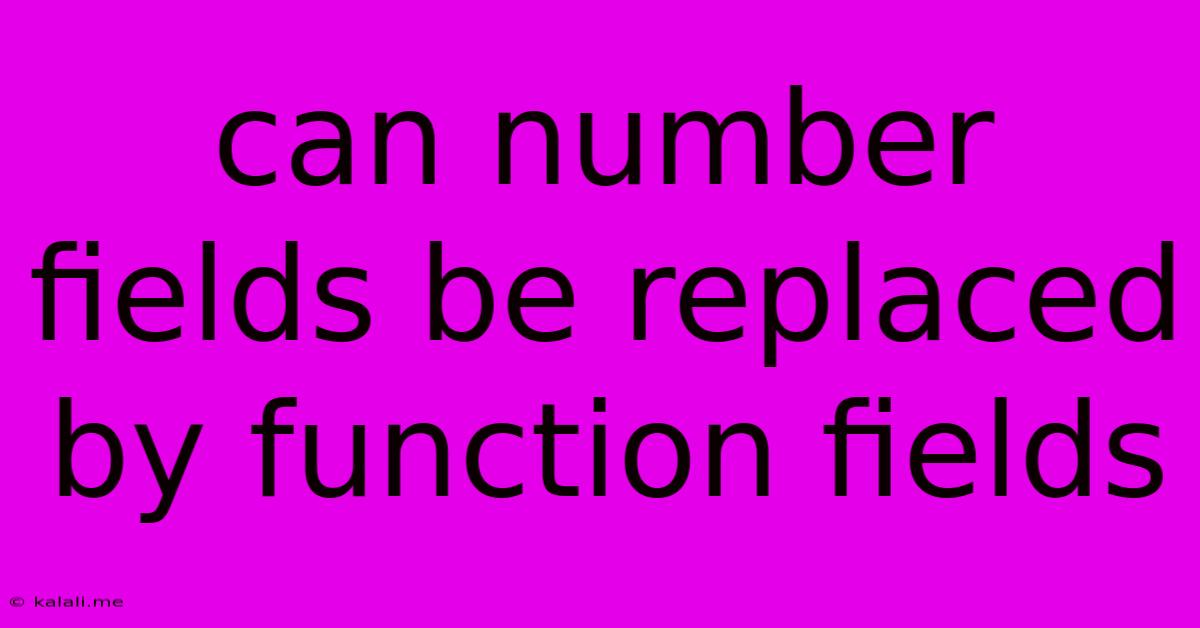Can Number Fields Be Replaced By Function Fields
Kalali
May 23, 2025 · 3 min read

Table of Contents
Can Number Fields Be Replaced by Function Fields? Exploring the Analogies and Differences
This article delves into the intriguing question of whether function fields can serve as replacements for number fields in certain mathematical contexts. While both are crucial in algebraic number theory and related fields, their properties differ significantly, making a direct substitution generally impossible. However, understanding the analogies and differences provides valuable insights into the structure of these mathematical objects. This exploration will focus on their similarities, highlighting where analogies hold true, and their contrasting characteristics, emphasizing the limitations of replacing one with the other.
Similarities and Analogies Between Number Fields and Function Fields
Both number fields and function fields are extensions of base fields. Number fields are finite extensions of the field of rational numbers (ℚ), while function fields are finite extensions of the field of rational functions in one variable over a finite field (e.g., F<sub>q</sub>(t), where F<sub>q</sub> is a finite field with q elements). This shared characteristic of being finite extensions forms a foundation for some analogous properties. For example:
- Ring of Integers: Both possess a ring of integers, which plays a vital role in their arithmetic. In number fields, this is the ring of algebraic integers. In function fields, it's typically the ring of regular functions.
- Prime Ideals: Both exhibit the concept of prime ideals, crucial for factorization and understanding the arithmetic structure. The decomposition of prime ideals in extensions is a central theme in both areas.
- Valuation Theory: The theory of valuations plays a crucial role in analyzing both number fields and function fields. This allows for a quantitative measure of the "size" of elements.
- Riemann-Roch Theorem: While stated differently, versions of the Riemann-Roch theorem exist for both function fields and number fields (the latter being Arakelov geometry), giving insights into the geometry of these objects.
These similarities have led to fruitful cross-fertilization of ideas between the study of number fields and function fields. Many concepts and techniques developed in one area have found applications in the other.
Key Differences and Limitations of Replacement
Despite these analogies, significant differences prevent a direct replacement of number fields with function fields:
- Characteristic: Function fields have a non-zero characteristic (the characteristic of the underlying finite field), while number fields have characteristic zero. This fundamental difference impacts many aspects of their arithmetic, notably the behavior of Frobenius automorphisms.
- Archimedean Valuations: Number fields possess archimedean valuations (related to the absolute value), which are absent in function fields. This absence significantly affects analytic techniques applied to number fields.
- Geometry: Function fields are closely tied to algebraic curves over finite fields, providing a rich geometric interpretation. Number fields lack such a direct geometric counterpart, although Arakelov geometry attempts to bridge this gap.
- Applications: The applications are distinct. Number theory uses number fields to study Diophantine equations, algebraic integers, and related concepts. Function fields find applications in coding theory, cryptography, and the study of algebraic curves.
Conclusion
While number fields and function fields share striking similarities in their algebraic structures, their differing characteristics, particularly the characteristic and the presence of archimedean valuations, prevent a simple substitution of one for the other. The analogies are valuable tools for gaining deeper understanding in both areas, sparking cross-pollination of ideas and techniques, but the fundamental differences highlight their distinct roles in mathematics and their unique applications. The parallels are useful for understanding concepts in one context through the lens of the other, but a direct replacement is not feasible.
Latest Posts
Latest Posts
-
The Difference Between Garbage And Waste
May 23, 2025
-
Black Oxide Vs Titanium Drill Bits
May 23, 2025
-
Why Magic Action Is Not Working 2024
May 23, 2025
-
Where Are Sound Files Stored On Sonoma Mac
May 23, 2025
-
How To Do Brackets Inside Of Brackets
May 23, 2025
Related Post
Thank you for visiting our website which covers about Can Number Fields Be Replaced By Function Fields . We hope the information provided has been useful to you. Feel free to contact us if you have any questions or need further assistance. See you next time and don't miss to bookmark.